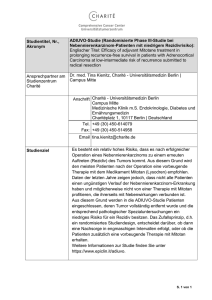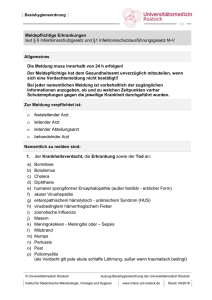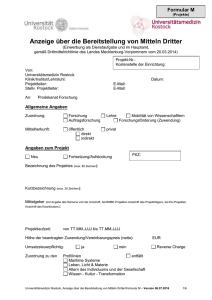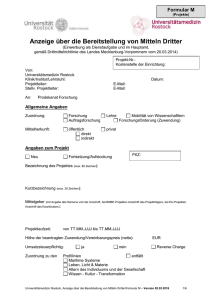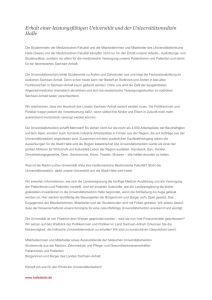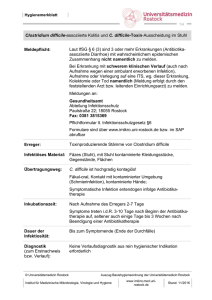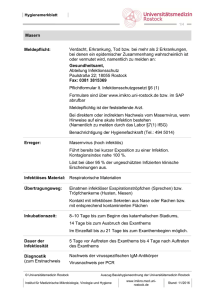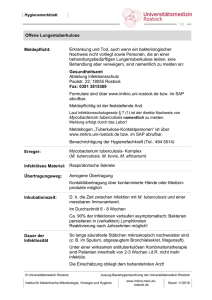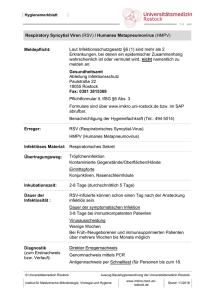Seltene Differentialdiagnose einer pelvinen zystischen
Werbung
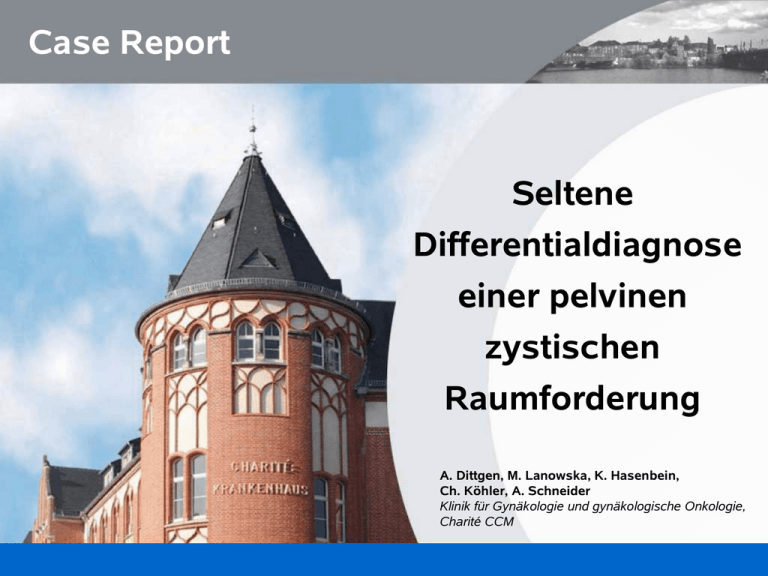
Case Report Seltene Differentialdiagnose einer pelvinen zystischen Raumforderung A. Dittgen, M. Lanowska, K. Hasenbein, Ch. Köhler, A. Schneider Klinik für Gynäkologie und gynäkologische Onkologie, Charité CCM UNIVERSITÄTSMEDIZIN BERLIN 1 Anamnese • 39-jährige Patientin (172cm, 72kg, guter AZ) größenprogrediente mehrkammrige zystische Raumforderung Adnexbereich rechts, asymptomatisch (in Routine-Vaginalsonographie festgestellt) • III-Gravida, III-Para (Z.n. 3x SPP ´02, ´04, ´07) • Menarche mit 14. Lj., Menses unauffällig (28d/5d) • aktuell kein Kinderwunsch • Letzter PAP: 02/09 o.B. • Familienanamnese, Eigenanamnese & Sozialanamnese unauffällig UNIVERSITÄTSMEDIZIN BERLIN 2 Befund • Abd.: weich, indolent, kein DS, keine AS, NL beidseis frei • Insp.: albus V/V reizlos, Schleimhaut unauffällig, Portio glatt, Fluor • Palp.: Uterus anteflektiert, normal groß, derb, mobil Adnexe und Parametrien frei, kein Tumor palpabel • TVUS: Uterus anteflektiert, normal groß, zyklusgerechte ED, keine freie Flüssigkeit im Douglas Ovar links unauffällig, normal groß im Ovarbereich rechts zystisch- solider Tumor 5x5 cm, gekammert • Labor: unauffällig, CA-125 i.N. UNIVERSITÄTSMEDIZIN BERLIN 3 Sonographie (transvaginal) Adnexbereich rechts UNIVERSITÄTSMEDIZIN BERLIN Adnexe links Ovar rechts 4 Operation – diagnostische LSK Douglaszytologie: o.B. UNIVERSITÄTSMEDIZIN BERLIN 5 MRT MRT: ausgeprägte sakrale Wurzeltaschenzysten bds. (2.& 3.SWK) Neurochirurgische Empfehlung: keine Op-Indikation, da asymptomatische, gutartige Fehlbildung UNIVERSITÄTSMEDIZIN BERLIN 6 Differentialdiagnosen • Gynäkologisch: Ovarialzysten (Endometriose, Dermoid, funktionelle Zysten), Tubo-Ovarial-Abszess Saktosalpinx/ Hämatosalpinx, benigne und maligne Tumoren des Ovars, Peritonealzysten (retroperitoneale Hydatiden) • • • Sakrale Wurzeltaschenzysten Sakrale Meningozelen Präsakrale Tumore: − − − − − − • • • Schwannom Embryonaltumore (Müller-Tm, Teratome, z.B. Epidermoidzysten) Atypischer Sinus pilonidalis Zystisches Harmatom Neuroendokrine Karzinome Mesotheliome Lymphangiome / Lymphangioendotheliome / Lymphozelen Echinokokkus-Zysten Mukozelen (Appendix vermiformis Remnant) UNIVERSITÄTSMEDIZIN BERLIN 7 Literatur 1. Köhler C, Kuhne-Heid R, Klemm P, Tozzi R, Schneider A: Resection of presacral ganglioneurofibroma by laparoscopy. Surg Endosc 2003;17:1499. 2. Renzulli P, Candinas D: Symptomatic retroperitoneal cyst: a diagnostic challenge. Ann R Coll Surg Engl 2009;91:W9-11. 3. Coco C, Manno A, Mattana C, Verbo A, Sermoneta D, Franceschini G, De Gaetano A, Larocca LM, Petito L, Pedretti G, Rizzo G, Lodoli C, D'Ugo D: Congenital tumors of the retrorectal space in the adult: report of two cases and review of the literature. Tumori 2008;94:602-607. 4. Surendrababu NR, Cherian SR, Janakiraman R, Walter N: Large retroperitoneal schwannoma mimicking a cystic ovarian mass in a patient with Hansen's disease. J Clin Ultrasound 2008;36:318-320. 5. Ibraheim M, Ikomi A, Khan F: A pelvic retroperitoneal schwannoma mimicking an ovarian dermoid cyst in pregnancy. J Obstet Gynaecol 2005;25:620-621. 6. Manson F, Comalli-Dillon K, Moriaux A: Anterior sacral meningocele: management in gynecological practice. Ultrasound Obstet Gynecol 2007;30:893-896. 7. Freier DT, Stanley JC, Thompson NW: Retrorectal tumors in adults. Surg Gynecol Obstet 1971;132:681-686. 8. Lee RA, Symmonds RE: Presacral tumors in the female: clinical presentation, surgical management, and results. Obstet Gynecol 1988;71:216-221. 9. Hatipoglu AR, Coskun I, Karakaya K, Ibis C: Retroperitoneal localization of hydatid cyst disease. Hepatogastroenterology 2001;48:1037-1039. 10. El Ajmi M, Rebai W, Ben Safta Z: Mucocele of appendiceal stump--an atypical presentation and a diagnostic dilemma. Acta Chir Belg 2009;109:414-415. UNIVERSITÄTSMEDIZIN BERLIN [email protected] 8 Zusammenfassung • Keine Entfernung / Biopsie einer unklaren retroperitonealen, zystischen Raumforderung: Es kann sich um eine Wurzeltaschenzyste mit Verbindung zum Spinalkanal handeln. Bei großer Leckage und Liquoraustritt > 60ml besteht die Gefahr der cerebralen Einklemmung. • Im Zweifelsfall 2-zeitiges Vorgehen: Im MRT mit KM abklären, ob es eine Verbindung zum Spinalkanal gibt. UNIVERSITÄTSMEDIZIN BERLIN 9 Vielen Dank für Ihre Aufmerksamkeit! UNIVERSITÄTSMEDIZIN BERLIN 10
